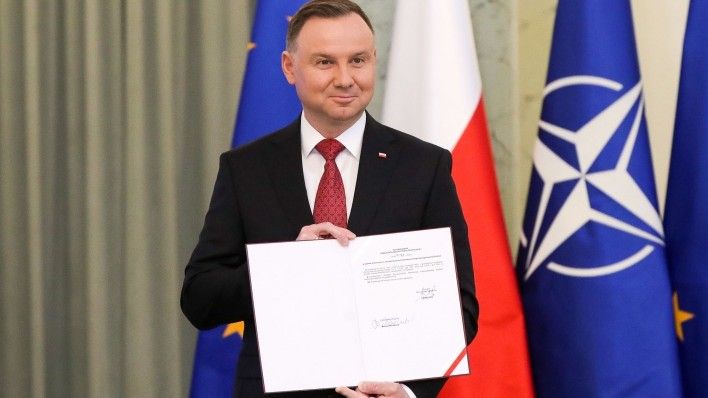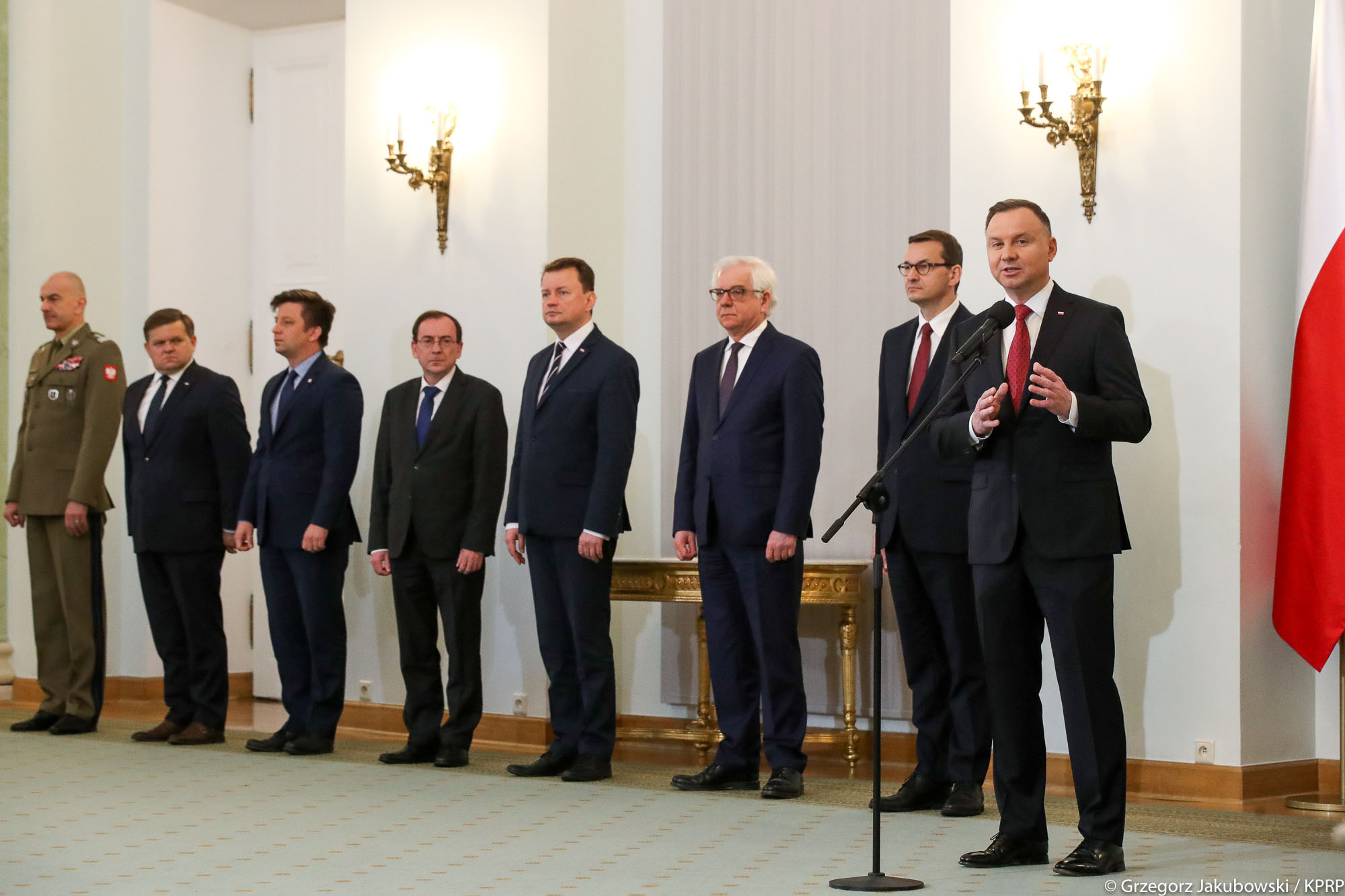President Signs the Polish National Security Strategy. New Threats & Back to the Roots [COMMENTARY]

President Andrzej Duda has just approved the new National Security Strategy, following a request submitted by the PM. What are the provisions contained within that document, becoming valid on the date of conclusion and automatically replacing the previous iteration, approved back in 2014?
The document first outlines the current international situations and dynamics thereof, that we could have been observing over recent years and that led to the drafting of a new national security strategy. According to the authors, we could have witnessed a decomposition of the international order that makes it difficult for Poland to pursue national interests and accomplish the goals of strategic nature.
Requirements and Threats
The problems listed include uncertainty, lack of respect for international law, or even a higher number of threats. In particular, the above list also mentions the Russian policy and acts of aggression accompanied by advancements in the area of A2/AD systems and offensive military potential. The document lists the Kaliningrad and the Baltic Sea regions among the threat domains, also pointing to exercises based on a conflict involving the NATO member states, rapid deployments of large military elements, and use of nuclear weapons as the potential issues of concern.
The strategy also emphasizes the aggressive actions taken by Russia that have a hybrid profile. These are usually aimed at destabilization of the NATO and its allies. They also entail a risk of a conflict emerging. The hybrid activities include disinformation and cyber warfare. The document claims that:
The Russian Federation will continue its policy of undermining the current international order, based on international law, in order to rebuild its power and spheres of influence.
This is to weaken the stance adopted by some of the NATO member states - western European nations are indicated here, as within the EU framework the concept of development seems to be incoherent, the document suggests.
Thus, Poland is to be strongly embedded within the NATO and EU structures, also pursuing bilateral cooperation with its most important regional partners. Regional and internal conflicts south of Europe are also considered to be a threat, along with the migration pressure that is still viewed as a pan-European security challenge. Competition between the US, China, and Russia has been considered to be a phenomenon of concern as well. As a result of that competition, the line between peace and war has been blurred, with proxy conflicts of varied intensity also becoming more frequent.
Global insecurity is also fueled inter alia by the undermining of disarmament treaties and agreements, proliferation of weapons of mass destruction and the threat of terrorism and organised crime. Activities below the threshold of war, including hybrid ones, will continue to constitute an important policy tool serving both state and non-state actors in achieving their objectives. One can expect further development of capabilities allowing to carry out activities in many domains, including cyberspace and outer space.
New threats posed by technological advancement also become more pronounced, including AI, UAVs, robotized platforms, stand-off PGMs, cruise, and ballistic missiles. The use of nuclear weapons as a tool for de-escalation has also been an interesting trend here.
On the other hand, the development of high tech domains such as broadband communications, quantum technology, nanotechnology, or AI altogether makes it possible to establish new defence and development capacity.
Interest in the national security domain includes, according to the new strategy:
- Guarding of independence, territorial integrity, sovereignty, and security of the state and its citizens.
- Shaping international order, based on solidarity and respect for international law, which guarantees the safe and secure development of Poland.
- Strengthening national identity and guarding national heritage.
- Ensuring conditions for sustainable and balanced social and economic development and environment protection.
Armed Forces
The Armed Forces of Poland are to continue the reinforcement followed by enhancement of the operational capabilities and the deterrence capability. A particular emphasis is to be placed on increased mobility and modernization. Thus, the increased defence expenditure is to reach a level of 2.5% of GDP in 2024. The command structure is also expected to evolve, to match the current requirements. The quantities of personnel and equipment are to be brought to a “full inventory” status. The new requirements (asymmetric warfare, net-centric battlefield) are also going to be taken into the account in the training curriculum.
The hybrid warfare is to be one of the primary training areas for the SOF component in particular, during “all possible extraordinary states and in states of defence readiness”. The military is also expected to be capable of establishing A2AD systems and increasing the maneuverability of operations, with the ability to stay away from permanent dislocation for longer periods. This is to be accompanied by investment in infrastructure and logistics.
The document also indicates the emerging need to create a national integrated situational awareness system making use of a broad range of reconnaissance, communication, and command assets, including national Earth observation systems and UAVs embedded within a net-centric environment. National satellite communications capability is also expected to be established, along with air/missile defence capabilities to follow. The latter probably refers to the continuation of investment in the Wisła air defence programme, Narew programme that is pursued in sync with Wisła and the F-35/Harpia procurement. The strategy also contains the declaration: Poland is to establish precision stand-off capabilities.
Moreover, anti-tank and air defence capabilities are expected to be upgraded. These domains have become obsolete in the Polish military - reinforcement is necessary to establish an ability to conduct effective operations in a conventional scenario. Ideas pursued by the domestic industry have a critical meaning here. These include Piorun and Pirat missiles, Poprad SHORAD systems, Ottokar-Brzoza tank destroyer, or, finally, the ZSSW-30 turret integrated with the Spike-LR ATGMs.
The air defence systems have been put alongside the anti-aircraft domain which probably suggests that protection of own forces would be emphasized alongside the protection of critical infrastructure - here, the Narew system would be involved as well.
The “operational capabilities” are to be obtained, to carry out a full spectrum of military operations. For that purpose, Cyber Defence Forces are to be established along with capabilities to conduct activities in space as well as to carry out information activities.
The Navy is to be capable of protecting the maritime interest and to conduct joint operations in regional and allied settings. Conditions are to be created for the Polish defence industry to “regardless of the ownership” meet the long-term requirements of the Polish military, and to carry out and implement R&D projects. This could be viewed as steps taken to get the private industry involved here - during the recent years it has been kept away from the key procurements, such as the Rosomak BMS system or Orlik UAV programmes.
Territorial Defence Forces are expected to be further developed, creating conditions for the development of common civic defence readiness in the territory of the whole country. The mobilization system is to be enhanced - including the system for training the personnel.

State-Level Systemic Changes
The security is to be established through the implementation of changes aimed at integrating the management of security matters, including the directing of national defence and establishing adaptability. The strategy reads as follows here: “Create an interagency coordination mechanism for the management of national security through setting up a committee of the Council of Ministers, responsible, at the strategic level, for dealing with issues in the field of policies, strategies, and programmes pertaining to national security management, in a manner ensuring their consistent and coherent implementation and linking the committee with the new role and competences of the Government Crisis Management Team and the Government Centre for Security.”
The national crisis management center is to be adjusted to and coordinated with the crisis response system of NATO. The domestic system is also to be extended “to the field of political and military conflict and allowing for a smooth transition from the state of peace to the state of crisis and war, as well as ensuring that it provides effective tools to prevent and combat threats, including hybrid ones”.
The resilience is to be enhanced through the “creation of a civic defence, based on the efforts of the entire nation, and building an understanding” and social awareness here.
This is to be achieved through the use of potential offered by the national and local authorities, education system and higher education bodies, local communities, the economy, NGOs, and the citizens. Civil/civic defence is to become more common, being redefined and adapted to the current needs. Continuous adaptability is also to be available, to match the evolving threats. The resources necessary to protect the society during a crisis are also expected to be maintained and collected. The protection of the critical infrastructure has particular relevance here. The strategy mentions the “continuation” of reinforcement of counterintelligence-based protection of the state organs and the critical infrastructure. The intelligence services are to be more potent to recognize threats in advance. The investment in the area of spatial management is to be implemented with defence and security requirements taken into account.
Increased inter-ministerial coordination is to translate into coordination for increased efficiency of the domestic industrial and tech potential in the domain of defence. The changes are also expected to happen in the strategic reserves system, according to the changes in the security environment. The manufacturing capacity, when it comes to reserves, refers to technologies available and the manufacturing output as well. The above is associated with the urgent requirements emerging as the COVID-19 pandemic became a burning issue. One of the sections of the strategy states that “selective launch of actions to mobilise the economy and to meet the needs of the Polish Armed Forces” shall be a part of the process aimed at increasing the state’s resilience. The above would mean that manufacturing shall begin with regards to elements required to mobilize the state in crisis circumstances (non-military crises included).
Furthermore, cryptography capabilities are also one of the primary areas of focus. The above also refers to the manufacturing of cryptography-enabled communication systems made with the use of microelectronic components manufactured in Poland. The software for those is also expected to be developed locally.
International Cooperation
The new strategy also places a major emphasis on international cooperation, within the framework of the EU and NATO. Becoming a member state has changed the Polish position, in the area of security. Undertaking efforts as such is recommended within the framework of UN, OSCE, and through bilateral projects on a state-to-state basis. The latter domain shall be expanded, reinforcing Poland’s position as a relevant element of international security.
This refers primarily to cooperation with the US in the defence and security domain (including the permanent presence of the US forces in Poland), as well as in the areas of technology, trade, and in the energy sector. Bi- and multi-lateral cooperation are to be deepened in the Bucharest 9, Visegrad Group, the Weimar Triangle, and in other formats.
Poland is to work for reinforcement of the states in the east. The above refers to, primarily, Moldavia, Georgia, and Ukraine. All of these nations are to be supported on their way to achieve their European and Euro-Atlantic objectives. Poland is still to be involved in stabilization activities in the east. These activities would also include the Eastern Partnership (EaP) countries.
The necessity to work in the area of reinforcing the international law and arms controls, disarmament, and non-proliferation movements (WMD domain), has also been strongly emphasized. Poland is also to be involved in missions and operations led by international organizations. The document devotes a lot of content to the expansion of the road, harbour, railway and airport infrastructure (including the CPK Central Commuting Port project) in Poland. Not only would the capabilities obtained in this manner reinforce the country’s economy, but they would also increase the chance to carry out an effective defence operation involving the allies.
What’s next?
The new National Security Strategy briefly defines the challenges that the Polish security system would face. Even though the document is brief, when compared to the former Strategy (38 pages instead of 54), it addresses the challenges related to the changes in the security domain following the outbreak of conflict in Ukraine. The strategy directly states that the activities undertaken by the Russian Federation are the primary threat to the Polish national security, as Moscow is expanding a broad spectrum of its military capabilities, including the nuclear ones. Several other threats have also been listed, including ones related to healthcare or energy security.
The necessity to establish a common defence system plays a key role in the new strategy, alongside the Polish military. When it comes to the Polish military, the requirement to increase the quantitative potential that it has is emphasized in particular, alongside the recovery of reserves and a broad scope of modernization. The modernization includes air/missile defense systems (that have been a priority since the inception of the former Strategy), reconnaissance and intel-gathering capability, information- and cyber-warfare, the Navy, as well as conventional and “hard” capabilities, including anti-tank and anti-aircraft systems. The strategy thus shows that the Polish military needs to be reinforced with the new technological challenges in mind, alongside conventional threats.
All of the above is to be possible thanks to the defence expenditure increased to the level of 2.5% of GDP. This claim is interesting, especially in the light of the COVID-19 pandemic and deteriorating financial situation. Most clearly, reinforcement of the Polish military has been considered to play a role relevant enough not to be subjected to crisis-related cuts. Notably, the domestic defence industry is to be at the foundation of the modernization - “regardless of the ownership”. This could be interpreted as a guideline for the MoD to take the privately-owned potential into account as well. The above outline is not exhaustive. Discussion of the strategy as a whole requires an in-depth analysis that takes all aspects of security into account.

WIDEO: Defence24 Days 2025: Premier Defence & Security Conference in CEE